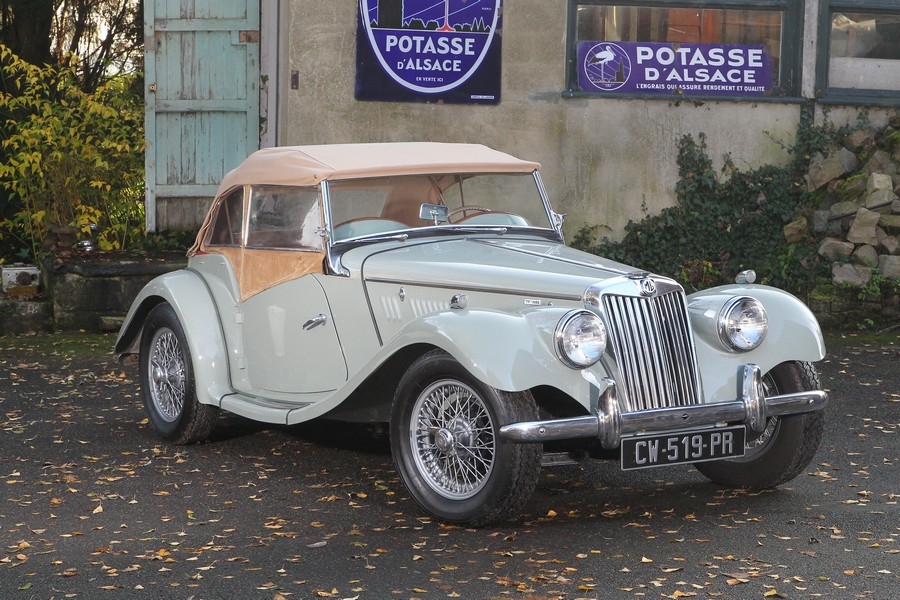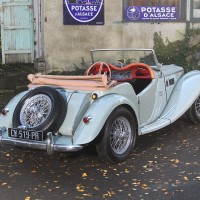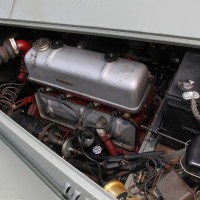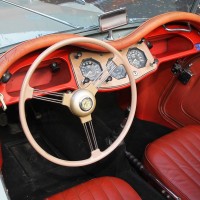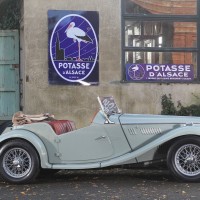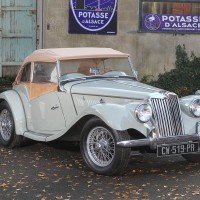SCM Analysis
Detailing
| Vehicle: | 1955 MG TF 1500 Roadster |
| Number Produced: | 3,400 (for the TF 1500) |
| Original List Price: | $1,995 |
| Distributor Caps: | $25 |
| Engine Number Location: | Stamped on an octagonal brass plate that is riveted to the right side of the engine block. |
| Website: | http://www.nemgtr.org |
| Investment Grade: | B |
This car, Lot 333, sold for $70,576, including buyer’s premium, at Bonhams’ Les Grandes Marques du Monde au Grand Palais sale in Paris, France, on February 6, 2014.
The MG TF is often considered an iconic car, but it is an ironic one as well. The TF is ironic in that it was thrust onto the market as a freshened version of its predecessor, and it was meant to serve as a stopgap model to fill North American demand until the MGA went into production in 1955. Yet it became the best of the long line of T Series MGs in terms of power and comfort, although given the levels of power and comfort of its predecessors, the bar was set pretty low.
Folklore holds that to have followed the TF’s predecessor, the MG TD, with the MGA in 1953 — as could have occurred — would have diminished sales of the then-new Austin-Healey 100. Leonard Lord, chairman of the fledging British Motor Corporation, came from the Austin side of the new organization, and so MG was relegated to producing an updated TD that would not challenge Healey sales at the time of its launch.
Introduced later in the same year as the Austin-Healey 100 and the Triumph TR2, it would be easy to conclude that the TF would fail to excite, given its comparatively anemic 57.5 horsepower (at this level we count even half of a horsepower) compared to 90 horsepower for the Healey and Triumph. The up-engined TF 1500, introduced in 1954, had increased power at 63 hp, but the Healey and the Triumph could each exceed 100 mph — quite a feat in the day — while the TF 1500 reached its highest speed at around 85 mph.
Reputation and a bargain price
So why did this car succeed, given its antiquated pre-war styling, anemic performance and status as a gap-filler while awaiting introduction of the MGA? The answer to that question may be the immense loyalty that MG built up in North America with the TC and TD processor models — plus simple economics. The MG cost far less than the Healey, and while the Healey and Triumph were new on the American scene, the MG already had a large and devoted following.
To the uninitiated, the TF may look very similar to its predecessor model, the TD. However, it incorporated some important modifications that make it significantly different. For the first time in the T Series, the headlamps were faired into the fenders, giving the car a much smoother, less spindly look. It also had a sloping grille and a new pressurized cooling system. The external radiator cap is a fake, as the real one is concealed in the engine compartment. Additionally, the TF was three inches lower than the TD.
However, tradition dies hard, and while the TF gained some styling updates, its octagonal gauges were pure throwback to earlier MGs, and the lack of a fuel gauge speaks of an era that was already bygone even when the TF was in production.
Plenty of originality
This particular example is painted the lovely and original Birch Gray, with the correct red interior. This is a refreshing break from red with black, and it presents an understated elegance. The dashboard and the brackets on the seat backs are correctly painted to match the interior color, and in fact, the paint looks as though it is original. The center dash panel is the correct bronze color and also appears to have its original paint.
Wire wheels were a popular option on the TF. This example has 60-spoke wheels, while the originals were 48-spoke wheels. Modern radials have replaced the original, narrow bias-ply tires, but the stronger wheels and radial tires are forgivable upgrades for the sake of increased safety and performance.
A grubby engine and all the money
The sale price of €51,750 ($70,576) of our subject car fell within Bonhams’ pre-auction estimate of €45,000–€65,000 (about $62,000–$90,000), but it is far above the SCM Pocket Price Guide range of $35,000–$45,000. And this money came despite the careless presentation of the car, with oily grime covering portions of the engine compartment — including the distributor cap. The car also carried a thick layer of dust on the air filter canisters, fuel-stained float bowls and the uninspired choice of a common parts-store battery in an otherwise vintage engine compartment.
However, someone apparently saw through those issues, and there cannot be many TFs in this original — albeit grubby — condition. And despite a recent external repaint, the “survivor factor” also appears to be in play here. Nevertheless, I call this TF well sold. ♦
(Introductory description courtesy of Bonhams.)
